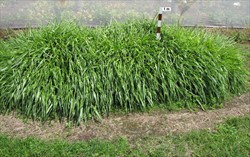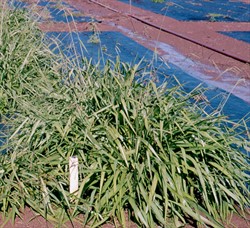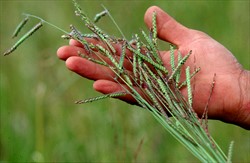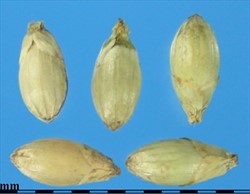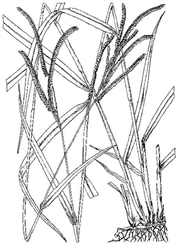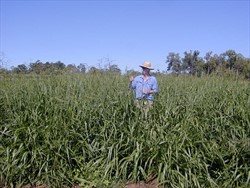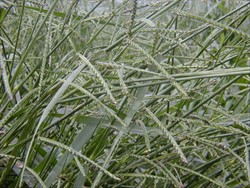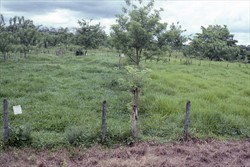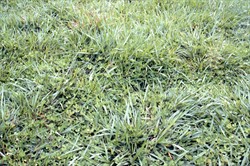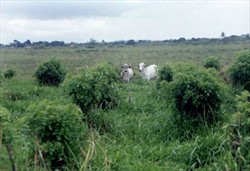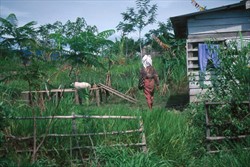Urochloa brizantha
Tropical Forages
Urochloa brizantha (Hochst. ex A. Rich.) R.D. Webster
Basionym: Panicum brizanthum Hochst. ex A. Rich.; Brachiaria brizantha (Hochst. ex A. Rich.) Stapf
Family: Poaceae (alt. Gramineae) subfamily: Panicoideae tribe: Paniceae subtribe: Melinidinae.
Loosely tufted perennial with short rhizomes and erect or slightly decumbent stems 60–150 (–200) cm high. Leaf blades flat, linear to lanceolate, bright green, 3–20 mm wide and 10–100 cm long; glabrous or hairy. Inflorescence a panicle comprising (1–) 2–16 racemes, 4–20 cm long borne along one side of a central axis 3–20 cm long; rachis crescentic in section, narrowly winged, semiterete, 1 mm wide, ciliate on margins; spikelets packed in regular, single row along the rachis. Spikelets elliptic, 4–6 mm long, subacute or acute, falling entire; glumes dissimilar, reaching apex of florets, thinner than fertile lemma; lower glume ovate, pex obtuse, or acute, clasping, 1/3 length of spikelet, membranous, without keels, 7–11-veined; upper glume oblong, length of spikelet, cartilaginous, without keels, 7–9-veined, surface glabrous or pubescent, apex obtuse or acute.
Similar species
U. brizantha: culms erect or geniculately ascending, more tufted habit; racemes (1–) 2–16, 4–20 cm long; rachis 3–20 cm long, crescentic in section, narrowly winged, 1 mm wide; spikelets subacute or acute, 4–6 mm long, packed in single row along rachis; lower glume ovate, 7–11-veined, apex obtuse or acute; upper glume oblong, cartilaginous, 7–9-veined, surface glabrous or pubescent, apex obtuse, or acute.
U. decumbens: culms decumbent, stoloniferous forming a denser cover; racemes 2–7, 1–5 cm long; rachis 1–8 cm long, flat, broadly winged, 1–1.7 mm wide; spikelets subacute or acute, 4–5 mm long, packed in 2 rows along rachis; lower glume ovate, 9-veined, apex obtuse or acute; upper glume oblong, membranous, 7-veined, surface pubescent, apex obtuse or acute.
U. ruziziensis: culms decumbent, stoloniferous forming a denser cover; racemes (3–) 5–7 (–9), 5–10 cm long; rachis 4–12 cm long, broadly winged, foliaceous, with rounded midrib, 2–3.5 mm wide; spikelets cuspidate, 4–5 mm long, packed in two rows along rachis; lower glume oblate, 11–13-veined, apex obtuse; upper glume oblong, membranous, 7-veined, surface pilose, hairy above, apex acute.
Africa: broodsinjaalgras, aufrechtes armgras (Afrikaans); kamuxi, ocinde linene (Angola), gawrare, ashama uku (Nigeria), zinyaruzoka (Shona, Zimbabwe)
Asia: หญ้าซิกแนลต้นตั้ง ya siknaentontang (Thailand)
English: big ashama, bread grass, Ceylon sheep grass, large-seeded millet grass, Mauritius grass, palisade grass, palisade signal grass, sheep grass, signal grass, St Lucia grass, Surinam grass, upright false paspalum
German: Palisadengras
Latin America: braquiarão, braquiária, braquiária-do-morro, brizantão, brizantha, capim braquiária, capim-Marandu, capim ocinde, Marandu (Brazil); bracherón, brachiaria de Abisinia, estrella de Africa, pasto alambre, pasto braquiaria, pasto señal, señal, zacate señal, zacate signal (Spanish)
Native:
Africa: Botswana, Cameroon, Cote D'Ivoire, Democratic Republic of the Congo, Ethiopia, Ghana, Guinea, Kenya, Malawi, Mozambique, Namibia, Nigeria, Sierra Leone, South Africa (n. & e.), Tanzania, Uganda, Zaire, Zambia, Zimbabwe.
Cultivated/naturalized:
North America: USA (Texas)
Caribbean: Trinidad and Tobago
Central America: Honduras
South America: Argentina, Bolivia, Brazil, French Guiana, Venezuela
Forage
Permanent pasture for grazing and cutting for fresh feed and for conservation; also planted as a pasture under plantation crops.
Environment
Used as a ground cover for erosion control, but less effective than the stoloniferous U. decumbens. Erect-growing varieties also used for erosion-controlling hedgerows.
Soil requirements
U. brizantha grows on a wide range of well-drained, light to heavy textured soils of pH 4–8. It is tolerant of high Al+++ concentrations often found on soils with pH<5.5. Tolerance of Mn varies among ecotypes. Minor response to lime has been obtained on very acid soils. While it can survive on soils of low fertility, it requires medium to high soil fertility to be productive, slightly higher than required by U. decumbens and U. humidicola for good growth.
Moisture
Best adapted to the humid and sub-humid tropics with 1,500–3,500 mm average annual rainfall, but will also grow in the more arid regions of the tropics with rainfall somewhat below 1,000 mm. Can withstand dry seasons of 3–6 months, during which the leaf may remain green when other tropical species have browned off. It is generally intolerant of poorly drained soils and flood tolerance varies; e.g. ‘Toledo’ can stand short-term flooding (<1 month), ‘Marandú’ has little tolerance.
Temperature
B. brizantha is a warm-season grass occurring from 25º S to 12º N in Sub-Saharan Africa at altitudes from 100 to 2,300 m asl in the tropics, but only to 1,000 m asl in higher latitudes. Leaf is frost-tender, but plants survive light frost.
Light
It has moderate shade tolerance, and has been useful in more open coconut plantations (>60% light transmission). At low N inputs, DM yields have been higher in shade than in full sunlight.
Reproductive development
U. brizantha is predominantly polyploid, reproducing primarily by facultative pseudogamous aposporous apomixis. Diploid sexual accessions are known but have little or no commercial value.
Defoliation
Can tolerate frequent defoliation under grazing or cutting. Taller varieties are available that are more suited to cutting.
Fire
Burning is not recommended but plants will recover from an occasional, but not annual, fire.
Guidelines for establishment and management of sown forages.
Establishment
Large areas are established from seed. Fresh seed will not germinate due to physiological dormancy and must be stored for 6–9 months or acid-scarified before sowing. Seed should be broadcast at 2–4 kg/ha onto a well-prepared seedbed and then lightly harrowed and rolled to incorporate. U. brizantha is readily established vegetatively from rooted tillers.
Fertilizer
Very responsive to fertilizer N, and may require repeated moderate applications, being sure to correct P deficiency since there is often no response to N in the absence of additional P. In cut-and-carry systems, fertilizer should be applied after each cut to maintain production.
Compatibility (with other species)
Lightly grazed U. brizantha provides good ground cover and weed control. Under light grazing, many twining legumes will persist in the sward (better than with other commercial species of Urochloa). Creeping legumes such as Arachis spp. and Grona heterocarpa subsp. ovalifolia will combine well under more intensive grazing. Very vigorous growth can inhibit development of young rubber trees in establishing plantations. As an intercrop, competition from U. brizantha reduced yields of soybean (Glycine max) by 40–50% and of upland rice (Oryza sativa).
Companion species
Grasses: Urochloa hybrids, U. decumbens, U. dictyoneura, U. humidicola depending on soil conditions and insect challenge (e.g. cercopids).
Legumes: Alysicarpus vaginalis, Arachis spp., Calopogonium mucunoides, Centrosema molle, Grona heterocarpa ssp. ovalifolia, D. intortum, Leucaena leucocephala, Neustanthus phaseoloides, Stylosanthes spp.
Pests and diseases
U. brizantha is the most resistant of the Urochloa spp. to spittlebugs (Cercopidae), through an antibiotic mechanism. However, the level of resistance varies among accessions. ‘Marandú’ and a number of bred lines are resistant. Resistance to the spittlebug Deois flavopicta is probably from antinexosis, antibiosis and tolerance. Variable susceptibility to spider mite (Tetranychus urticae Tetranychidae), a particularly important factor in "push-pull" systems. Tolerant of leaf-cutting ants (Atta spp. and Acromyrmex spp.). Brown or burrowing bug (Scaptocoris Hemiptera, Cydnidae) has caused severe damage to commercial ‘Marandú’ pastures. Foliar leaf blight (Rhizoctonia solani) affects all accessions of U. brizantha except for CIAT 16320, which has low to moderate levels of resistance. Susceptible to rust (Uromyces setariae-italicae) in Colombia. Bacterial root rot (Erwinia chrysanthemi pv. zeae) can be a problem in poorly drained soils. A condition known as Marandu Death Syndrome (síndrome da morte do capim-marandu) occurs in stands growing on even temporarily waterlogged soils or subjected to short periods of inundation, where large patches of the stand die out.
Ability to spread
Good spread from seed in sown forages. However, ‘Marandu’ appears to have some form of allelopathic effect which reduces seedling recruitment of its own seed.
Weed potential
Common weed of disturbed areas in the humid tropics and subtropics.
Nutritive value
Nutritive value is dependent on the basic fertility of the soil, fertilizer application and age of regrowth. In tropical America, CP ranges are 7–16% and digestibility 51–75%. IVDMD of regrowth declined from 75% at 2 weeks to 55% at 12 weeks.
Palatability/acceptability
Well accepted by grazing stock. Considered to be slightly more palatable than U. decumbens.
Toxicity
Can cause severe photosensitization in sheep, goats and young cattle when used as the main feed. In Brazil however, where the grass (mainly 'Marandu') is particularly widely used, no photosensitization effects have been observed on cattle.
Feedipedia link
Dry matter
DM yields range from 8 to 20 t/ha/yr depending on ecotype, growing conditions, and management. It can be very productive and support reasonably high stocking rates with good persistence under continuous or rotational grazing. Good growth in the dry season.
Animal production
On moderately fertile soils, it can generally support cattle liveweight gains of 400–500 kg/ha/yr at stocking rates of 2.5 steers/ha in the wet season and 1.5 in the dry season. When associated with legumes and stocked at 3 animals/ha, ‘Marandú’ has recorded LWGs of 540–840 kg/ha. In Brazil, with 2.2–2.4 animals/ha, LWGs of 290–340 kg/ha/yr were recorded. In Costa Rica, ‘Marandú’ produced LWGs of 154 kg/head and 924 kg/ha with Arachis pintoi, and 110 kg/head and 714 kg/ha in a pure stand. ‘Toledo’ has produced 8–9 kg milk/head/day. LWGs of 600 g/head/day (307 kg/ha/yr) over 3 years in Paraná, Brazil have been reported.
U. brizantha is primarily an apomictic tetraploid (2n = 4x = 36). Diploid sexual accessions are known, but have no commercial value. Pentaploid and hexaploid types have also been described.
U. brizantha has been one of the main species used in interspecific breeding programs, the objectives of which were to develop hybrids with increased resistance to spittlebugs, leaf-cutting ants, and other biotic constraints, better edaphic adaptation, especially to infertile soils, and improved nutritive value. A gene for aluminium tolerance, neMDH, has been identified enabling transformed plants to tolerate aluminium solutions to 444 µmol /L.
Direct heading or hand harvest for yields of 100–500 kg/ha with 50–150 kg/ha pure seed, and up to 1,000 kg/ha pure seed with mechanical recovery (ground sweeping) of fallen seed. Seed may be dormant for up to 6 months after harvest.
U brizantha is susceptible to glyphosate, even at quite low rates, with minor differences among cultivars.
- Resistance to spittlebug attack (cv. Marandu).
- Good persistence under grazing.
- More compatible with legumes than some other Urochloa spp.
- Tall types are well suited to cutting.
- High seed production potential .
- Tends to monospecific sward.
- Needs moderate to high fertility soils.
- Not adapted to poorly drained soils.
- May cause photosensitization, particularly in sheep and goats.
Bogdan, A.V. (1977) Tropical Pasture and Fodder Plants. Longman Inc., New York, USA. p. 54.
Cezário, A.S., Ribeiro, K.G., Santos, S.A., Valadares Filho, S.C. and Pereira, O.G. (2015) Silages of Brachiaria brizantha cv. Marandu harvested at two regrowth ages: Microbial inoculant responses in silage fermentation, ruminant digestion and beef cattle performance. Animal Feed Science and Technology 208:33–43. doi.org/10.1016/j.anifeedsci.2015.06.025
CIAT. (1992) Pastures for the tropical lowlands: CIAT’s contribution. International Center for Tropical Agriculture (CIAT), Cali, Colombia. hdl.handle.net/10568/54510
Costa, L.K.P., Santos, M.E.R., Silva, G.P., Carvalho, B.H.R., Pessoa, D.D., Galzerano, L. and Silva, N.A.M. (2016) Reduction of sward height in the fall/winter as strategy to optimize tillering in Urochloa brizantha syn. Brachiaria brizantha. Archivos de Zootecnia 65:499–506. uco.es/ucopress/az/index.php/az/article/view/1917
Lenné, J.M. and Trutmann, P. (eds). (1994) Diseases of Tropical Pasture Plants. CAB International, Wallingford, Oxon, UK.
Miles, J.W., Maass, B.L. and Valle, C.B. do (eds). (1996) Brachiaria: Biology, Agronomy, and Improvement. CIAT, Cali, Colombia. p. 16–35. hdl.handle.net/10568/54362
Peters, M., Franco, L.H., Schmidt, A. and Hincapié, B. (2003) Especies forrajeras multipropósito: Opciones para productores de Centroamérica. Centro Internacional de Agricultura Tropical (CIAT), Cali, Colombia. hdl.handle.net/10568/54681
Schultze-Kraft, R. (1992) Brachiaria brizantha (A. Rich.) Stapf. In: Mannetje, L.’t and Jones, R.M. (eds) Plant Resources of South-East Asia No. 4. Forages. Pudoc Scientific Publishers, Wageningen, the Netherlands. p. 56–58. edepot.wur.nl/327785
Thomas, D. and Grof, B. (1986) Some pasture species for the tropical savannas of South America. III. Andropogon gayanus, Brachiaria species and Panicum maximum. Herbage Abstracts 56:557–565.
Valle, C.B. do, Simioni, C., Resende, R.M.S. and Jank, L. (2008) Melhoramento genético de Brachiaria. In: Resende, R.M.S., Valle, C.B. do and Jank, L. (eds) Melhoramento de Forrageiras Tropicais. Embrapa Gado de Corte, Campo Grande, MS, Brazil.
'Arapoty' (CIAT 16488, BRA 004391) Registered, not released, Embrapa, Brazil (2003). Early flowering; efficient extraction of P and strong response to applied P; susceptible to spittlebugs. Initially misidentified as Brachiaria (Urochloa) decumbens.
'Braúna MG 13' Released Matsuda, Brazil (2015). Bred cultivar. Decumbent growth, recommended for soils of medium to high fertility, adapted to sandy soils, used for grazing and hay production.
'BRS Paiaguás' (CIAT 16467, BRA 003891, EAI 13277, ILCA 12751, K-071) Released Embrapa, Brazil (2013). Origin Nairobi, Kenya (1⁰17' S, 1600 m asl, rainfall 900 mm). Selected for moderate to high yields (ca. 15 t/ha DM/yr). Good growth during dry periods, susceptible to spittlebug.
'BRS Piatã' (CIAT 16125, BRA 002844, E 020, ILCA 13372) Released Embrapa, Brazil (2007). Origin Welega, Ethiopia (9⁰49' N, 1,810 m asl, rainfall 2,000 mm). Selected for intermediate to high fertility soils. Drought tolerant, good growth during dry periods, resistant to spittle bug. Higher feeding value than other cultivars. More tolerant of spider mite (Tetranychus urticae) than 'Marandu', 'Mulato II', and 'Basilisk'.
'Capiporã' (CIAT 16315, BRA 003441) Registered, not released Embrapa, Brazil (2003). Late flowering. High DM production but lower LWG/animal and ha.
'Karanga' (CIAT 16835) Unofficial release in Southeast Asia (1990s). Origin Masvingo, Zimbabwe (20⁰6' S, 1,200 m asl, rainfall 800 mm). Taller variety growing to 2 m.
'La Libertad' (CIAT 26646, BRA 006289, ILCA 16551) Released ICA, Colombia (1987), 'MG 4' Released Matsuda, Brazil (1994). Origin unknown. Adapted to poorer soils than ‘Marandu’. High tolerance of manganese reaching high Mn levels in the shoot without causing visual symptoms of toxicity. More tolerant of spider mite (Tetranychus urticae) than 'Marandu', 'Mulato II', and 'Basilisk'.
‘Marandu’ Released Embrapa, Brazil (1984), 'Brizantha' Cuba (1987), 'Gigante' Venezuela (1989), 'Insurgente' Mexico (1989), 'Diamantes 1' Costa Rica (1991) (CIAT 6294, CIAT 6780, BRA 000591, CPI 81408, ILCA 16550, CNPGC 127/78, CPAC 3099, IRI 822). Origin Kenya. Good spittlebug resistance. Requires intermediate to high fertility soils. Widely planted in tropical America. Relatively intolerant of water-logging. Subject to Marandu Death Syndrome in temporarily flooded or waterlogged situations. Susceptible to spider mite (Tetranychus urticae).'Serengeti' (CIAT 6387, BRA 002453, FAO K 75232A-E) Unofficial release in Southeast Asia (1990s). Origin Rift Valley, Kenya (0⁰40' S, 1,200 m asl, rainfall 1,300 mm). A moderately short variety (<1 m tall) forming a sward (similar to U. decumbens cv. Basilisk).
'Toledo' Released in Costa Rica (2000), 'Victoria' Colombia (2002), 'Xaraés' Brazil, Embrapa (2003), 'MG 5 Vitória' Brazil, Matsuda (CIAT 26110, B-070-1, BRA 004308, ILCA 14773). Origin Bubanza, Burundi (2⁰53' S, 1,500 m asl, rainfall 1,700 mm). Selected for soils of intermediate to high fertility and rainfall >1,600 mm. Late flowering, high yield and drought tolerance for dry season production but susceptible to spittle bug. More resistant to foliar blight and Fusarium than ‘Marandu’, and recovers faster from defoliation. More prostrate than ‘Marandu’. Used for erosion control on fragile hillsides in smallholder systems in Honduras and Nicaragua. More tolerant of spider mite (Tetranychus urticae) than 'Marandu', 'Mulato II', and 'Basilisk'.
CIAT 6016, CIAT 6387 Selected in Brazil. Highest yielding in Brazilian savannas.
CIAT 6385, CIAT 26124, CIAT 26318, CIAT 26990 Selected in Colombia. Origin Rift Valley, Kenya, Burundi, Rwanda and Uganda.
CIAT 16300 (BRA 003301, E 141-A, ILCA 13598) Selected in Costa Rica. Origin Jima, Ethiopia (7⁰54' N, 1,640 m asl, rainfall 1,600 mm).
CIAT 16320 (BRA 003492, ILCA 13648) Selected in Colombia. Origin Yubdo, Ethiopia (8⁰56' N, 1,750 m asl, rainfall 1,680 mm). Pollen parent for 'Cayman' and 'Cobra'.
BRA 004391 Selected in Brazil. Origin Nakuru, Kenya, 1,900 m asl . Most tolerant of water-logging of several accessions.
ILRI 12991 (ex Kenya) and ILRI 13810 (ex Ethiopia). More tolerant of spider mite (Tetranychus urticae) than 'Marandu', 'Mulato II', and 'Basilisk'.
